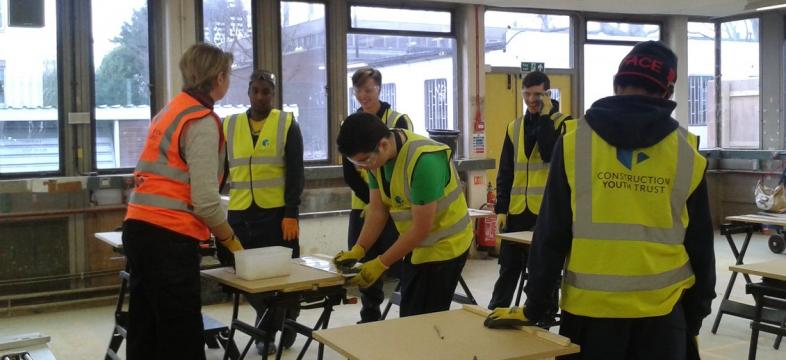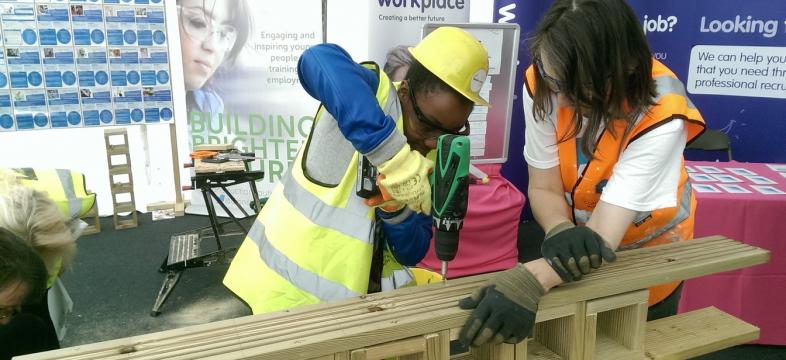Main author
Michael BrooksInterview with Carol Lynch, CYT
The UK is facing a construction skills shortage caused by an ageing workforce and the return to economic growth. At the heart of the problem is the lack of young people coming into the industry - only about 10% of those working in the construction are aged between 19 and 24, with just 1-2% aged between 16 and 18.
Construction Youth Trust (CYT) is a charity helping young people in England and Wales to build better futures by giving them access to training, education and employment opportunities in the construction industry.
Designing Buildings Wiki sat down with Chief Executive, Carol Lynch to discuss the work and challenges facing the CYT, from Brexit, to construction’s lack of appeal, and schools’ failure to understand non-academic routes.
| Designing Buildings Wiki (DBW): Could you tell us about your new Pledge a Placement initiative? |
Carol Lynch (CL):
Construction Youth Trust (CYT) is very much about connecting young people with employers. The construction industry still tends to recruit people firstly, who have experience, and secondly, by word-of-mouth and personal recommendation.
We are trying to break down some of the barriers that young people, particularly from disadvantaged backgrounds or groups that are traditionally under-represented in the industry, still face.
The Pledge a Placement Initiative was part of our '#ExperienceConstruction' campaign launched last year, asking organisations to sign up to show they are willing to take on students for work placements.
| DBW: Women make up only 11% of the construction workforce in the UK and just 1% of workers on site. Your ‘#notjustforboys’ campaign has been tackling this head-on in recent months. How have you found this so far and do you see the situation altering in the near future? |
CL:
The campaign has really succeeded in achieving what it originally set out to do, which was to start a conversation and encourage more young women to consider a career in the industry. We have had some fantastic support from the industry, including Network Rail and Go Construct, but there is still a long way to go.
There’s some really interesting things happening in the industry at the moment. Mark Farmer, in his report Modernise or Die, predicts that between 1 and 4/5 of the workforce is going to leave the industry because of the older demographics.
Now, with Brexit, it has really brought the skills shortage into sharp relief. From what I hear, it does feel like the industry is starting to understand that relying on a migrant workforce rather than having some sort of homegrown workforce is a precarious position to be in.
We’ve got a two-pronged job – one is about changing the perception of young people who might enter the industry, the other is to make sure when they do come in, the industry reflects the kind of modern workplace that we all expect in this day and age. That cultural shift will take time, but it won’t change unless we get more young people of diversity coming into the industry.
| DBW: Where do you think the construction industry has failed, and continues to fail, to appeal to young people as an attractive career path? |
CL:
When young people think of construction they think of physical, dirty work in unpleasant weather conditions. There are jobs that fit that description, but there are a whole range of knowledge-driven, digital-driven roles too. We need to sell the industry of tomorrow to young people.
One of the difficulties is that the industry is very fragmented, and all the big contractors and institutes go in to schools giving a slightly different message. What we need to do is come together and present one message as an industry, rather like the armed forces do when they get behind very powerful campaigns.
At the moment we are still operating in a piecemeal way, and to use the old adage, fighting over pieces of the pie rather than trying to enlarge it.
| DBW: Would you like to see the education system doing more to encourage construction careers? |
CL:
Absolutely. Teachers and schools do not understand construction very well. They understand the academic, A-levels-to-university route; they don’t understand the more technical non-academic routes quite as well. Also, schools have vested interests in children staying in schools, even if A-levels are not the most appropriate ‘next step’ for a 16-year-old.
The government has done a lot of work on the new Trailblazer apprenticeship and the Post-16 Skills Plan. The key idea behind the Sainsburys report was that we need to have a technical route given parity with the academic route.
There’s no industry where that learn-and-earn, work-based route is more appropriate than the built environment, and we see promotion of that as a key role for the CYT.
| DBW: In the government’s Housing white paper, released earlier in the week, one of their strategy proposals was to ‘take steps to address skills shortages by growing the workforce’. How would like to see them substantiate this rather vague proposal? |
CL:
Really good careers advice is important in terms of young people not falling through the cracks. Measures drive behaviour, and what we need to measure schools on is the destination of young people and how well they help them make that post-16 transition, rather than just GCSE results. Like all of us, if we are held to account for certain measures, that will drive our behaviours.
We need to have a much more strategic approach so that we can say to a young person – in this locality over the next 5-10 years there’s going to be a shortage of roofers or glaziers, so if you train in this area you will get a job at the end of it. The data is there, but we need to link it up with careers advice that is given to young people.
| DBW: Do you think the low apprenticeship wages deter young people? Should the government think about raising this? |
CL:
It’s a huge deterrent, but I don’t think construction is the worst; a lot of our partners do promise a more decent apprentice wage.
For some vulnerable people, the apprenticeship wage is a real barrier, it may affect their family’s benefit, or there’s no way they can live on it on their own. We are certainly encouraging construction partners to consider going over and above the apprenticeship wage.
There is an argument that says, if a young person is in full time education, they aren’t getting paid anything. Employers’ agencies argue that someone has to pay the cost of education, and by asking the employer to pay a higher apprenticeship wage that young person’s education costs is being pushed on to the employer, whereas the government is paying for them if there are in an FE college and not earning anything. That’s worth reflecting on.
| DBW: Trade groups like UCATT say that with almost 40% of construction output coming from the public sector, government must only award contracts to those who take on apprentices. What’s your take on that idea? |
CL:
I agree, I think the public sector, and bodies like housing associations, have a real responsibility to use their buying power to change behaviour. There does need to be a continuing dialogue; sometimes the tickboxes that happen in procurement relationships or in section 106s around planning, have unintended consequences that don’t necessarily help young people.
We’ve also seen private sector developers using their client status to change behaviour intelligently. They say, ‘we want you to have apprentices, we recognise that creates some unintended consequences, so can you demonstrate that you are working towards having 3% apprentices across your whole business, with the acceptance that they may not be on our site?’
Clients, to change behaviour, are going to have to get smarter because this issue is critical to the British economy if we find we’re not able to build the housing and infrastructure we need.
| DBW: What are your thoughts on the risks that Brexit poses to the current construction workforce, potentially making the skills shortage even worse with a reduction in migrant labour from the EU? |
CL:
Certainly, it’s a major concern of our industry partners. In London, some partners’ onsite workforce are 60-70% EU nationals.
I think there will probably be some deal that will be done to accommodate that if it comes to it. But what Brexit has done is made us refocus attention on whether we are doing enough for our own reliable workforce.
| DBW: Do you think, if young people are not showing enough interest in going into construction, the emphasis should be adjusted and more should be done to encourage older people to retrain in the construction industry? |
CL:
Obviously our focus as a charity is to encourage young people, but in terms of what the industry needs, absolutely! I think what has been surprising about the whole apprentice push, is that it isn’t always young people who’ve stepped forward. A lot of older people have had career changes, and particularly with women, it might be something that takes a bit more thinking about.
We’ve been running a programme to encourage women to consider roles in building repair and maintenance for housing associations. Having women available to fill these role is often critical, for instance in women’s refuges and crisis centres for victims of domestic violence and other traumas, where it may not be appropriate to have unfamiliar men around vulnerable women.
What we have found with this programme however it is that sometimes it’s not necessarily the 16-year-olds but those in their 20s, 30s and 40s who consider a career in the industry.
| DBW: What originally inspired you into the industry? |
CL:
I did quite like the idea that I was going to be a woman in a man’s world. The reason I became an engineer is because I loved the idea of problem-solving with the resources that you have and having to create something out of it.
30 years ago when I was working on the Limehouse Link, there were very few women out on site. The stereotypical culture didn’t really bother me at the time, but that’s not really good enough, it might bother other people, so you have to challenge it however you can.
| DBW: What does CYT have lined up that you are most looking forward to in 2017? |
CL:
There’s such a fantastic opportunity in that CYT represents the whole industry, to say to young people that construction and built environment sector is a great work destination. Whatever that opportunity is, we can help people with the pathway. As a result, I think we’re in quite a unique position to help the industry resolve this communication and campaign issue of attracting young people.
The schools get individual companies knocking on their door, from different branches of industry, whereas the CYT can say – we will be the connection from your young people to the industry partners that are most appropriate for them as individuals.
We want to do more work in schools, and with people approaching their 16+ life choice. We’ll continue to work with young people who fall between the cracks; that will always be an important part of our role.
To find out more about the Construction Youth Trust, visit their website.
[edit] Related articles on Designing Buildings Wiki
- Budding Brunels Rail project.
- Diversity in the construction industry.
- Inclusivity in engineering.
- Interview with CITB.
- Interview with FMB.
- Interview with Julie Hirigoyen, UK-GBC.
- Interview with Kevin Borg, founder of KJB Building Consultants.
- Interview with Labour’s Shadow Housing Minister.
- Interview with Mark Farmer.
- Interview with Melanie Leech, BPF.
- Interview with Structural Timber Association.
- Owen Hatherley interview.
- Skills shortage.
- What does Brexit mean for construction?











